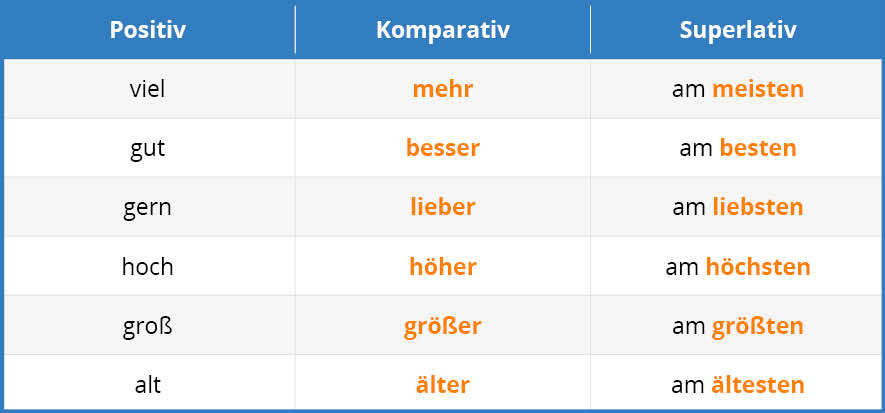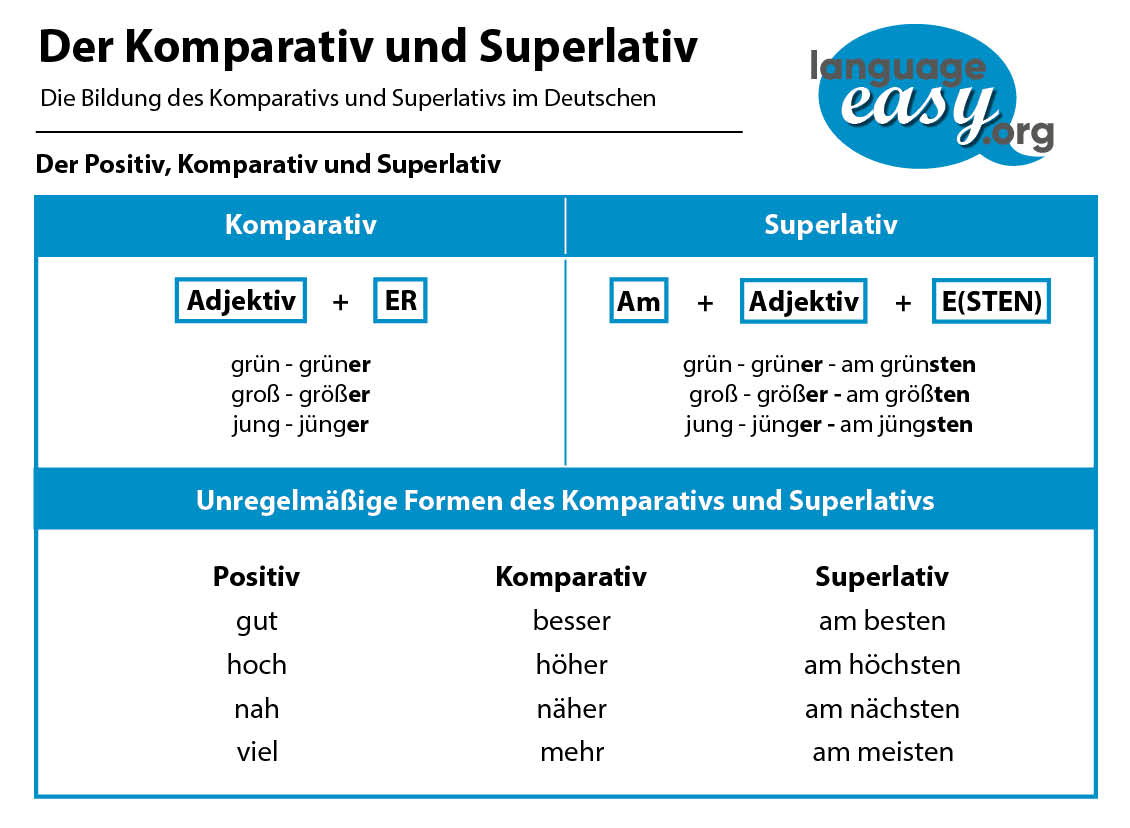German Superlative and Comparative
Superlativ und Komparativ im Deutschen – Erklärungen und Beispiele
German Superlative and Comparative – Summary
Zusammenfassung
Positive, Comparative and Superlative
Adjectives can have three different forms:
- Positive: “groß, schnell, stark”
- Comparative: “größer, schneller, stärker”
- Superlative: “größte(n), schnellste(n), stärkste(n)”
The positive form expresses the normal degree of intensity of the adjective.
By using the comparative form, you increase the intensity of it. It is often used to compare two objects, people, etc.
The superlative form is the form with the highest intensity.
Most adjectives have regular forms in comparative and superlative. There are only some exceptions, like in case an adjective has the ending “-el” or “-er”, the “e” in the comparative gets erased.
- “schön – schöner – schönste(n)”
- Here, the “e” in the comparative gets erased: “dunkel – dunkler – dunkelste(n)”
But there are some adjectives with irregular forms of comparative and superlative.
- “gut – besser – beste(n)”
- “viel – mehr – meiste(n)”
The comparison of the objects
When you compare two objects due to a specific attribute, they can be even or uneven. In case they are even, it is expressed by “so … wie“, and the positive form of the adjective is taken. In case they are not even, you express the comparative with “als” and the comparative form of the adjective has to be taken.
- “Philip ist so groß wie sein Bruder.”
- “Philip ist größer als sein Bruder.”
Well, let’s compare German and Chinese. So, in your opinion, which one of these two languages is easier to learn? Okay, probably you are an English speaker, and as English is a Germanic language, it is by far easier for you than Chinese. But, due to the fact that the English language has its roots in the German language, I would even say that German might be the easiest foreign language for English speakers to learn!
Ha, ha. Have you noticed what I just did there? Well, I betrayed you. Actually, I just needed some context to illustrate the topic we are going to talk about today. Exactly, today’s topic will be the German superlative and comparative! Hurrah!
So, after the magnificent introduction to this topic, we will define what we are actually talking about. After that, I’d like to show how you can use the German superlative and comparative in different situations – in the right way, of course. In the following, let’s clear up what German superlative and comparative actually are.
What is the German Superlative and Comparative?
Actually, it’s quite easy. Well, it’s a lot easier than… Ok, Ok… I’ll stop here. Let’s just try to clear up directly what we are talking about.
In case you want to compare two things, people, thoughts, actions, qualities or what so ever, you need a German comparative.
German superlatives are used when you want to make a claim that something, relative to all others, has the most or least of a given characteristic.
By the way, this definition is also valid for the superlative and comparative in the English language. So, due to these similarities, I don’t think that this topic will be too difficult for you.
Anyway, in case you want to compare things, people, thoughts, actions and so on, and these two compared attributes are equal, you just have to use the expression “so” (as) and “wie” (like) between them. Of course, instead of a German superlative or comparative. So, let’s have a look at some examples that will illustrate what we just tried to define.
- Comparison of equal attributes
“Ich bin so schön wie er” – I am as pretty as he is. - Positive adjective
“Ich bin schön.” – I am pretty. - German comparative
“Ich bin schöner” – “I am prettier” - German superlative
“Ich bin am schönsten” – I am the prettiest”
In the following part of this article about German superlative and comparative, we will have a look at the way these constructions are formed.
Formulas for German Superlative and Comparative
Formeln für den Superlativ und Komparativ im Deutschen
First of all, let’s try to figure out what it the formula behind the German superlative and comparative. So, let’s have a look at the English ones. Here, we have the two suffixes -er for the comparative and -est for the superlative. Well, it is actually a good idea to keep these forms in mind, because German superlative and comparative are formed in a really similar way.
The Basic Formula of German Superlative and Comparative
First, we will have a look at the word endings of adjectives and adverbs that are used to form German superlative and comparative. So, as we have already mentioned above, there is a huge similarity between the English and the German forms. Well, to form the German superlative and comparative, you add the following suffixes to the adjectives and adverbs.
- “-er” for comparative forms (“schnell-er” – faster)
- “-sten” or “-esten” for superlative forms (“schnell-sten” – fastest”)
Additionally, the word “am” comes before the adjective or adverb you want to express in the superlative form. But I’d like to talk about that a little bit more detailed later on.
Exceptions
Of course, we are learning German superlative and comparative. So, this means that there is no rule without an exception. In this case, there are some irregular German superlative and comparative forms in case of some monosyllabic adjectives. Unfortunately, you just have to learn them by heart, there is no other way to learn them. In the following, I’d like to show you a table with the most common irregular superlatives and comparatives.

Additionally, you have to keep in mind that in German, in contrast to English, you can not put forms like more or most in front of your adjective to form a German superlative and comparative.
Expressions for Sentence Building
Ausdrück zum Bilden von Sätzen
Comparative
Well, comparing things, thought, actions or whatever in English is actually quite easy: You simply use the word ‘than’. So, in German, you have a similar structure when you look at comparison: The word “als”. Logically, you construct a comparison as followed.
- “Ich bin schöner als er.” – I am more pretty than him.
As already mentioned above, you just use the suffix “-er” to form the comparative. After that, you add the word “als” and you are done.
Superlative
Now, let’s talk about the word “am” I have mentioned in the paragraph above. Well, “am” is simply the word you throw in when you want to express the German superlative. Actually, it’s a short version of “an dem” (at the).
We use it when we have a superlative that’s not sandwiched between an article and a noun, like in this example:
- Ich bin am schönsten.
So, you can notice clearly that, in comparison with the comparative, the word “am” comes before the adjective you express in the superlative.
Well, we have reached the end of this article about German superlative and comparative. Hopefully, I could give an idea the rules that form these forms of adjectives and some basics of their application.
Excercises
Übungen
Finally, we have reached the last part of this article where you can prove the German skills you have just learned. In the following you will see some phrases that you should complete with the correct terms. Once you have filled all the gaps, just click on the “correct” button and you can see your errors and the correct results. Good luck and… auf Wiedersehen!



